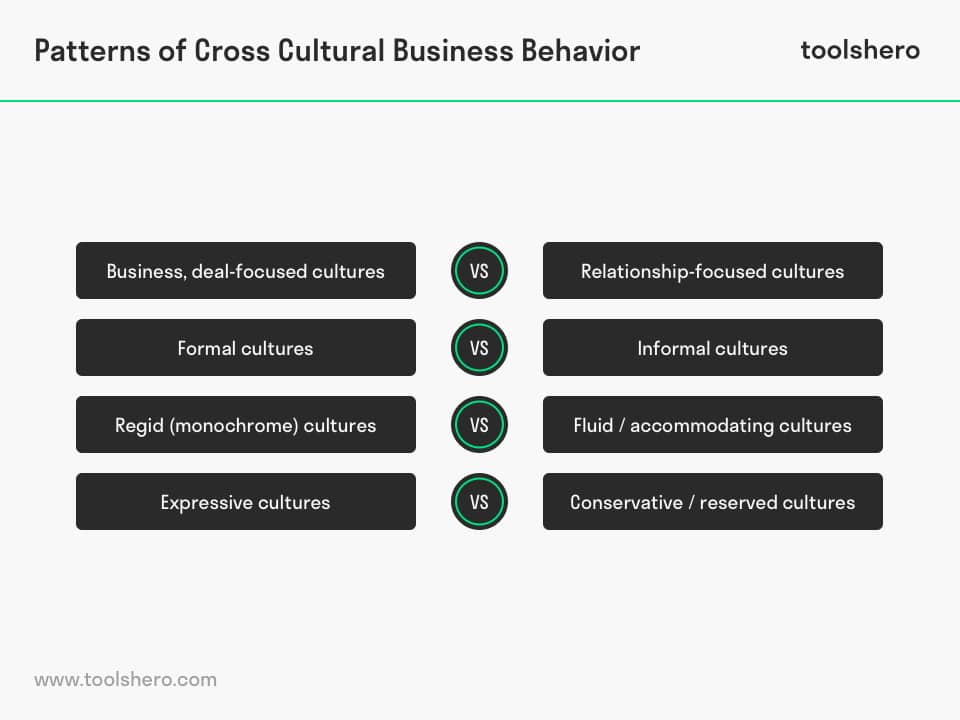Patterns of Cross Cultural Business Behavior

This article describes the concept of Patterns of Cross Cultural Business Behavior by Richard Gesteland in a practical way. After reading you will understand the basics of this powerful marketing tool.
What are the Patterns of Cross Cultural Business Behavior?
There are over 7,000 cultures all across the world. Each of them has different ideas and expectations when it comes to doing business.
In order to properly and effectively help different cultures, the American business guru and consultant Richard Gesteland analysed a unique set of expectations and assumptions from different countries and cultures. This makes it easier for people all around the world to conduct international business.
Patterns of Cross Cultural Business Behavior are about interpreting human behavior, that varies from culture to culture. But that shouldn’t be an obstacle for trade and/or doing business with each other. By getting to know each other’s culture and letting go of stereotypes, organisations are more open to each other.
Richard Gesteland published his ideas in 1999 with his book Cross-cultural business behavior, and he’s been a keynote speaker to audiences all over the world.
Doing business successfully
Patterns of Cross Cultural Business Behavior contribute to bridging the cultural gap between countries, taking each other’s preferences into account and understanding where differences come from. But it’s impossible to have all relevant information about all cultures.
As a researcher, Richard Gesteland has accumulated 30 years of experience in understanding human behavior. He believes that thorough knowledge of every culture’s habits is helpful when building successful business relations in international business.
Part of the activities of global companies and multinationals take place in different countries and are handled in different ways. They encounter differences in the legal system, low versus high production costs, different ways of interacting and different habits. Every country has its own rituals and values that are important to them.
By taking these cultural differences between countries into account, companies can more successfully do business with organisations abroad.
Four dimensions
With the information he obtained through research in different countries, Richard Gesteland created a manual about how best to approach different cultures and how one can best understand other cultures. This minimises conflicts between the negotiating parties. He developed four dimensions that characterise the culture of a country as part of his research. These four dimensions can be distinguished in relation to different cultures:
1. Business, deal-focused cultures versus relationship-focused cultures
This is the most important dimension according to Richard Gesteland. The difference is used as a basis for different cultures in business. The business, deal-focused are very task-oriented. They have no difficulty communicating with foreign cultures. To them it’s about the negotiations and the eventual transaction. Many problems are solved by phone or email and disagreements tend to be solved in writing rather than orally. This group consists mainly of Scandinavian and Germanic countries, North-America, Australia and New Zealand.
In the case of relationship-focused cultures, the negotiators find interaction more important than closing the deal. The interaction with the business partner needs to be right first, and there should be a foundation of trust. These cultures have an indirect communication style aimed at not offending the other party or creating the impression that there’s a lack of trust. Examples of this group are the Arab world, most of Africa, Latin America and Asia.
There’s a risk of conflict between these two opposites. People from relationship-focused culture often think negotiating partners from deal-focused cultures are harsh, pushy and aggressive. People from the deal-focused culture, think that the other culture is often vague and therefore unreliable and not decisive enough. By being aware of this difference in advance, deal-focused people can prepare by spending more time on negotiation and not expecting results right away. Relationship-focused would do well to indicate how important it is for them to have time to consider an offer to avoid annoying the other party.
2. Formal cultures versus informal cultures
In formal cultures, people prefer a respectful and honourable communication style. Differences in hierarchical position and status are considered very important and people are valued accordingly. Academic titles and royal ranks command respect. This applies in much of Europe, Asia, Mediterranean countries, the Arab world and Latin American countries.
Informal cultures are not being disrespectful, but do not put as much stock in difference in status and position. Everybody is equal and everyone has the chance or opportunity to advance. The United States, Australia, Canada, New Zealand, Denmark, Norway and Iceland are informal cultures.
These opposites can also experience conflict, for instance when a person from an informal culture gets too friendly and pats the CEO of a multinational from a formal culture on the back. Painful situations like that can be avoided by gathering knowledge beforehand, preventing it from being an obstacle to further business.
3. Rigid (monochrome) cultures versus fluid / accommodating cultures
Rigid cultures need everything to go exactly according to schedule with great precision. Arriving late is not the done thing and missing deadlines or meetings running late is unthinkable. Clear examples of this are Scandinavian and Germanic countries, North America and Japan.
Very different are the countries with a fluid attitude to time. People and interpersonal relations are considered more important than time, making deadlines or sticking to schedules. These polychrome cultures can be found in the Arab world, much of Africa, Latin American and South-east Asia.
Conflicts about time are unpleasant and often difficult to solve. After all, people from a rigid-time culture think in terms of ‘time is money’. Schedule overruns caused by the other party undermine trust. On the other hand, people from a fluid-time culture can be very surprised by a strong reaction to schedule overruns by the other party. ‘The job needs to get done, right?’ Here again it is important to come to clear agreements, avoid tight deadlines and evaluate along the way.
4. Expressive cultures versus conservative / reserved cultures
Expressive cultures are characterised by communicating loudly and with a lot of gestures. They do their best to avoid awkward silences and there is little consideration for personal space during conversations; people stand close together, often touch each other and look each other in the eyes. This is characteristic of Mediterranean countries, Southern Europe and Latin America.
People in reserved cultures tend to speak more calmly. General and continuous eye contact is avoided and they use little if any hand and arm gestures. This is characteristic of Southeast Asia and Northern Europe.
Both cultures can get annoyed by the other party’s behaviour. This is often expressed in non-verbal ways when the reserved party is keeping their distance or literally taking a step back. For this it’s also important to know who the negotiating party is and what is and what is not accepted in their culture. Acting modestly can make it easier to do business and come to an agreement.
Cultural groups
To distinguish between cultures, Gesteland has divided the most important countries in eight groups that have the characteristics of the dimensions mentioned earlier:
Group 1 – India, Bangladesh, Indonesia, Malaysia, Vietnam, Thailand, The Philippines
These countries are relationship-focused, formal in the way they interact, fluid when it comes to time and reserved.
Group 2 – Japan, China, South Korea, Singapore
These countries are relationship-focused, formal in the way they interact, rigid when it comes to time and reserved.
Group 3 – Saudi Arabia, Egypt, Greece, Brazil, Mexico
These countries are relationship-focused, formal in the way they interact, fluid when it comes to time and expressive.
Group 4 – Russia, Poland, Romania
These countries are relationship-focused, formal in the way they interact, fluid when it comes to time and expressive.
Group 5 – France, Belgium, Italy, Spain, Hungary
These countries are deal-focused, formal in the way they interact, rigid when it comes to time and expressive.
Group 6 – Baltic states
These countries are deal-focused, formal in the way they interact, rigid when it comes to time and reserved.
Group 7 – Great Britain, Denmark, Finland, The Netherlands, Czech Republic
These countries are deal-focused, formal in the way they interact, rigid when it comes to time and reserved.
Group 8 – Australia, Canada, United States
These countries are deal-focused, informal in the way they interact, rigid when it comes to time and expressive.
The cultural dimensions provide insight into the diversity and similarities between the different cultures. A company should be mindful of the characteristics and similarities a particular country has when it wants to do business with an organisation from that culture. The knowledge and skills gained from this research provides an opportunity to select relevant information about the culture in question and negotiate in an appropriate manner.
It’s Your Turn
What do you think? How do you deal with Cross Cultural Business Behavior? Do you recognize the practical explanation or do you have more additions? What are your success factors for good organizational culture alignment and development?
Share your experience and knowledge in the comments box below.
More information
- Gelfand, M. J., Erez, M., & Aycan, Z. (2007). Cross-cultural organizational behavior. Annu. Rev. Psychol., 58, 479-514.
- Gesteland, R. R. (2012). Cross-Cultural Business Behavior: A Guide for Global Management. Copenhagen Business School Press.
- Gesteland, R. R. (1999). Patterns of cross-cultural business behavior: Marketing, negotiating and managing across cultures.
- Lewis, R. D. (2005). When Cultures Collide: leading across cultures. Nicholas Brealey.
How to cite this article:
Mulder, P. (2017). Patterns of Cross Cultural Business Behavior. Retrieved [insert date] from toolshero: https://www.toolshero.com/marketing/patterns-cross-cultural-business-behavior/
Add a link to this page on your website:
<a href=”https://www.toolshero.com/marketing/patterns-cross-cultural-business-behavior/”>toolshero: Patterns of Cross Cultural Business Behavior</a>














2 responses to “Patterns of Cross Cultural Business Behavior”
Russia is in the group 4 and also in the group 7. Is it a misprint?
Hi Ludmila, thank you for your feedback. We’ve updated the article. Russia is only in group 4 (or D).